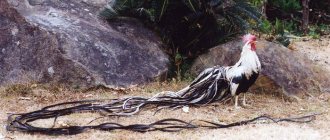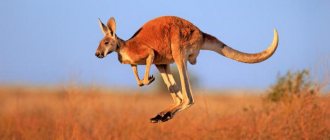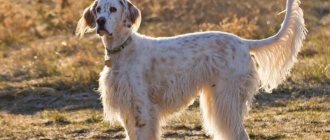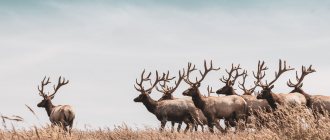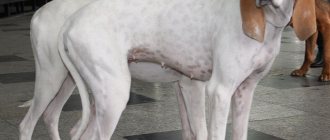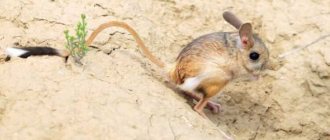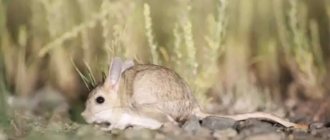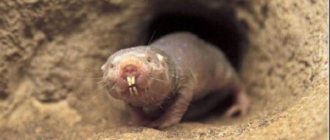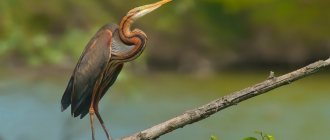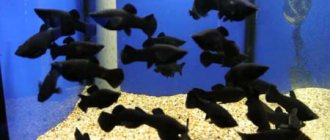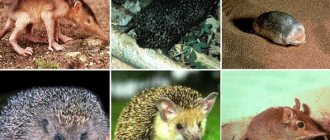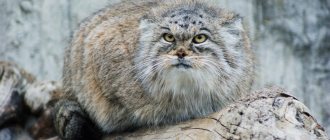general characteristics
Jerboas do not grow more than 27 cm, the smallest representatives do not exceed five cm. The weight of babies is from 100 to 350 g. The tail of jerboas is longer than the body, on average the length can reach 7 or 30 cm depending on the species. The long tail plays an important role during the movement of animals; it helps them balance when running and suddenly change direction. A raised tassel also serves as a signal of danger and alertness.
The jerboa's tail contains a reserve of fat, which is consumed during hibernation or the hungry period.
The body of jerboas is relatively short compared to the overall size. The length of the hind limbs is several times greater than the size of the front legs. Very rarely, jerboas use their forelimbs when walking, but most representatives of the species use only their hind limbs.
During their rapid movement, jerboas make ricocheting jumps, which, depending on the species, can reach 2–3 meters, which is hundreds of times the size of the animals.
Jerboas are capable of reaching speeds over short distances of up to 40 km/h. The faster the speed, the longer the jump.
The unique structure of the hind limbs helps to develop such speed. The three metatarsal bones are fused into one, which is called the tarsus; the lateral toes are either absent or less developed than the rest.
It has been noted that African jerboas have three-toed feet, while Asian species have five-toed feet. Each toe has well-developed claws; they are longer on the hind limbs than on the front limbs. In desert species, a kind of “brush” of hard hair grows on the foot, which provides a large area of support when moving on the sand and protects the foot from burns.
The head is large with a rounded, blunt or elongated muzzle. The neck of the animals is shortened, so it is almost invisible. In some representatives of the species, the cervical vertebrae are fused, which is why the body and head seem inseparable. The ears are large, round in shape; in some species the auricle grows together at the base into a tube.
The eyes, like those of all nocturnal inhabitants, are large and round in shape. Jerboas have very sensitive vibrissae, which are sometimes equal in size to the total length of the body.
Depending on the species, desert rodents may have 16 or 18 teeth. Surprisingly, when digging holes they use their teeth, and only push back the soil with their paws.
The fur of jerboas is soft and thick. The main color is uniform from brown to light sand. The chest and belly are white or painted the same color as the back.
Sex differences are mild. The color and body size of animals of different sexes are practically the same.
Key Features
Well-developed hind limbs allow the jerboa to move at incredible speed.
And if the distance is too great, the animal will overcome it by jumping. Only a few individuals use their front paws.
The jerboa's tail performs several functions at once - it helps to make sharp turns when moving at high speed, which is very important in steppe and desert conditions, thanks to it the animal can maintain balance and jump far.
In addition, the tail is an indicator of the health of the steppe animal. Depending on how it looks, you can determine how favorable the living conditions for the jerboa are.
This rodent prefers to lead a twilight and nocturnal lifestyle.
Most jerboas hide in their burrow during the day and come out only after dark, as can be seen in the photo above.
Interesting! In the steppes there are individuals that are diurnal. Such jerboas live in Kazakhstan. At sunrise they leave their hiding places and spend the entire day outside the hole. And they disappear only at dusk!
You can read about other unusual facts about animals in the article
Burrow construction
And the furry-legged one, and the long-eared one, and the big jerboa - they are all tireless workers. They constantly dig holes, which can be roughly divided into 4 main types:
- rescue, the depth of which reaches 20 cm;
- daytime - up to half a meter long;
- permanent - with a main inclined passage and spare ones, which are blind, the animal lays them very close to the surface;
- wintering rooms are equipped in a special way - they have pantries where the steppe animal hides supplies, and a wintering chamber, which is located at a depth of about 2 meters.
Interesting! When someone starts digging a permanent hole, the jerboa will immediately hide in one of the spare ones, tightly closing its roof!
The jerboa lives in a separate chamber, which is located in the far part of the hole. He lines his nest with fine grass
The meaning of the jerboa
For desert biocenosis, jerboas are very important. During their life activities, these rodents influence the vegetation and soil in their habitat.
These animals have many natural enemies, among them ferrets , for which they are a source of food.
But the role of the jerboa is not always exclusively positive. They can cause harm by destroying the vegetation that strengthens the sands and damaging the crops of cultivated plants.
Since the jerboa looks quite cute, it is difficult to imagine that it is capable of becoming the causative agent of such a dangerous disease as the plague.
And this is not the only disease that this steppe animal carries.
What do jerboas eat?
In search of food, jerboas can travel from 5 to 10 km during the night.
On average, one individual eats from 60 to 100 g of various food. The basis of the diet is plant seeds, flowers, green shoots, fruits, berries, cereal grains, vegetables, roots and tubers. Most species prey on insects and larvae.
Elena
Ask a Question
Question to the expert
What do you feed jerboas at home?
At home, jerboas are fed with special mixtures for small rodents, a variety of fruits and vegetables. As well as feeding insects, such as mealybugs, grasshoppers, moths or crickets. When keeping in an apartment, you should pay attention to the condition of the tail. In healthy animals it is round and mobile. If the jerboa is starving or sick, the tail looks emaciated and dirty with protruding vertebrae. This is due to the fact that rodents are able to store fat under the skin of their tail.
Nutrition
Jerboas feed mainly on vegetation. They consume seeds and rhizomes, which are first dug out of the soil, leaving noticeable holes in their place.
Depending on the place of residence and conditions, this animal can feed on insects and their larvae.
A jerboa eats about 60 g of various foods per day.
It is noteworthy that he does not drink water; the animal obtains liquid from plants. The rodent makes very long feeding passages and can cover a distance of 11 km in one night to feed itself.
Natural enemies
It is difficult to describe all the enemies of jerboas, since they are hunted by all predatory species. Small rodents are attacked by predatory animals, birds and reptiles. They are happily eaten by foxes, dogs, and representatives of the cat family.
Human activity also has a detrimental effect on small animals. Despite the fact that no one hunts most species of jerboas, rodents die during cultivation of fields, burning of bushes, construction of cities, dams, roads and other economic activities.
To some extent, fires and floods can be considered natural enemies. No matter how fast the jerboa is, it cannot escape from a steppe fire or escape from a stream of water. During floods and heavy rainfalls, many rodents become trapped in “houses” and die.
Population and species status
Due to the fact that there are many subspecies, as well as the fact that the reproduction process is stable, we can say that the jerboas are not in danger and their total numbers are at an optimal level. Despite this, there are subspecies that are on the verge of extinction.
It is important to know! The marsupial jerboa, which is considered an endangered species, lives in Australia. Therefore, recently the number of these animals is at a critical level.
These animals, like all living things on our Planet, deserve attention and careful treatment.
Interesting Facts
Jerboas are amazing creatures that have many features. It is quite difficult to study their habits in the natural environment, since rodents lead a rather secretive lifestyle.
Interesting:
- Jerboas do not need drinking water, since they obtain the required amount of liquid from the juice of plants, fruits and insects.
- Most species prefer to live alone, but during hibernation they can form groups. This helps rodents keep warm and not freeze.
- Despite their small size, jerboas are capable of reaching speeds of 30 to 40 km/h.
- Rodents navigate in the dark thanks to sensitive hearing, smell, night vision and sensitive vibrissae.
- Animals build many burrows with different purposes. This is quite unusual behavior for animals. The number of burrows can exceed several dozen.
- Jerboas have adapted to closing the entrance to their burrows with an earthen plug, which protects them from the heat and sensitive sense of smell of daytime predators.
- While running, the animals make zigzag jumps, which help them hide from predators.
- In most species, the ears are equal to or longer than the length of the muzzle. If you bend the ear forward, it will reach or cover the tip of the nose.
- The tail of the animals serves as a balancer and counterweight during sharp turns.
- Animals that inhabit the Sahara hibernate during the summer heat.
- The hind feet are covered with fur, thanks to which the animal can run on hot sand.
Jerboas are mysterious nocturnal creatures that attract the attention of scientists around the world. Even after many years since the beginning of the study, this species continues to amaze with unusual facts and interesting behavior.
Habitat
The jerboa is common in areas with hot and temperate climates. Their habitat covers Mongolia and North Africa, Central, Asia Minor and Western Asia, Kazakhstan and the south of Eastern Europe, as well as an area stretching from northeast China to southern Siberia.
Most varieties of jerboas are adapted to living conditions in deserts and semi-deserts, and only a few of them can live in the steppe, like lemmings , in the forest zone and in mountainous areas located at a distance of 2 km above sea level.
Just like the meerkat or mongoose , this animal is most often found in desert and semi-desert landscapes with clay and gravelly soils.
The jerboa digs its hole in the sand, the entrance to which is necessarily blocked with an earthen plug.
External signs
The muzzle is slightly elongated, somewhat flattened in front, the ears are long, the hind limbs are five-fingered, the main part of the “banner” is black, divided from below by a longitudinal white stripe, the end part is white. There is a clearly visible light field in front of the black part. The tail is long, up to 20 cm, and serves as a balancer when jumping. The tail "banner" is black with a white tip. The nose is in the form of a “piglet” - flattened in front.
The longitudinal groove on the dorsal surface of the penis almost reaches the apex and only barely branches into 2 short lateral grooves; the main part of it is without spines. The color of the top of the small jerboa ranges from brownish-rusty to light sandy; the belly, limbs and the stripe extending from the back to the thigh are white.
In the Pleistocene, reliable finds of remains are known far to the west of the limits of the modern range of the species - from the Paleolithic sites of the Crimea, and somewhat closer to the modern borders - from the alluvium of the Lower Don (Tsimlyanskaya, Nagavskaya) and the lower reaches of the Urals (Mergenevskoye, Chapaevo). Also known from Pleistocene asphalt of the Absheron Peninsula.
Behavior
Jerboas are usually nocturnal and crepuscular animals; during the day they remain in burrows. But, for example, daytime jerboas are also found on the territory of Kazakhstan.
Jerboa burrows are divided into 4 types. Rescue holes are simple passages 10-20 cm deep. Temporary daytime holes are from 20 to 50 cm in length, the entrance is closed with a plug of earth or sand, which keeps cool and moist inside. The permanent burrows are complex, containing a main inclined tunnel and several blind backup tunnels. If they start digging up a jerboa’s hole, it breaks one of the emergency passages and runs away. In the depths of the main tunnel there is a round-shaped living chamber, lined with chopped grass. The last type of burrows - wintering ones - are dug at a depth of 1.5-2.5 m, and consist of underground storerooms and a wintering chamber.
During the winter, many species of jerboas hibernate, just like dormouse.
Life is skipping
In the scarce living space of jerboa habitats, food sources are sometimes located at great distances, and in order to find them, you need to constantly move. To do this quickly, the animals have adapted to jump on their hind legs, while developing amazing speed. During the night they cover a distance of more than 10 km. Due to their jumping ability, jerboas often leave predators hanging. The length of the jumps can reach 1.5-3 meters (for such small animals this is simply a huge distance).
Description of the animal
Among several dozen species of jerboas, large animals are most suitable for home keeping. Large jerboas (order rodentia) are also called ground hares. These animals have a unique running style, which is of particular interest to buyers.
Read also: What is a nail primer for?
Rodents with long ears appeared on Earth several million years ago, gradually migrating from Asia to Africa. “Little kangaroos” moved to Europe much later. According to modern statistics, today the number of large jerboas on European territory is rapidly decreasing.
During the day, the animals are not very active; in the wild, their lifestyle is associated with the dark time of day. Large jerboas live in steppe and forest-steppe zones. There are many of them in Kazakhstan, the western regions of Siberia, Altai, and China. The animals choose habitats with hard soil and settle near small ponds or rivers.
Reproduction
In spring and summer, jerboas reproduce. In one year, a female is capable of bringing from 1 to 3 litters, each of which contains from 1 to 8 babies.
The gestation period lasts about 25-42 days. The female always gives birth in a hole in an individual nest.
The cubs are born blind and look like newborn rats.
When the body weight of a small jerboa reaches 200 g, it begins to gradually transition to independent life
Babies are under the care of their mother for quite a long time - about 1.5 months. During this period, they grow and gain weight up to 125 g. The cubs emerge from the burrow fully formed, but still move somewhat awkwardly.
Young jerboas are quite friendly and get along well next to each other. But after reaching three months, aggression begins to be traced in their behavior. This pushes the young animals to resettle.
